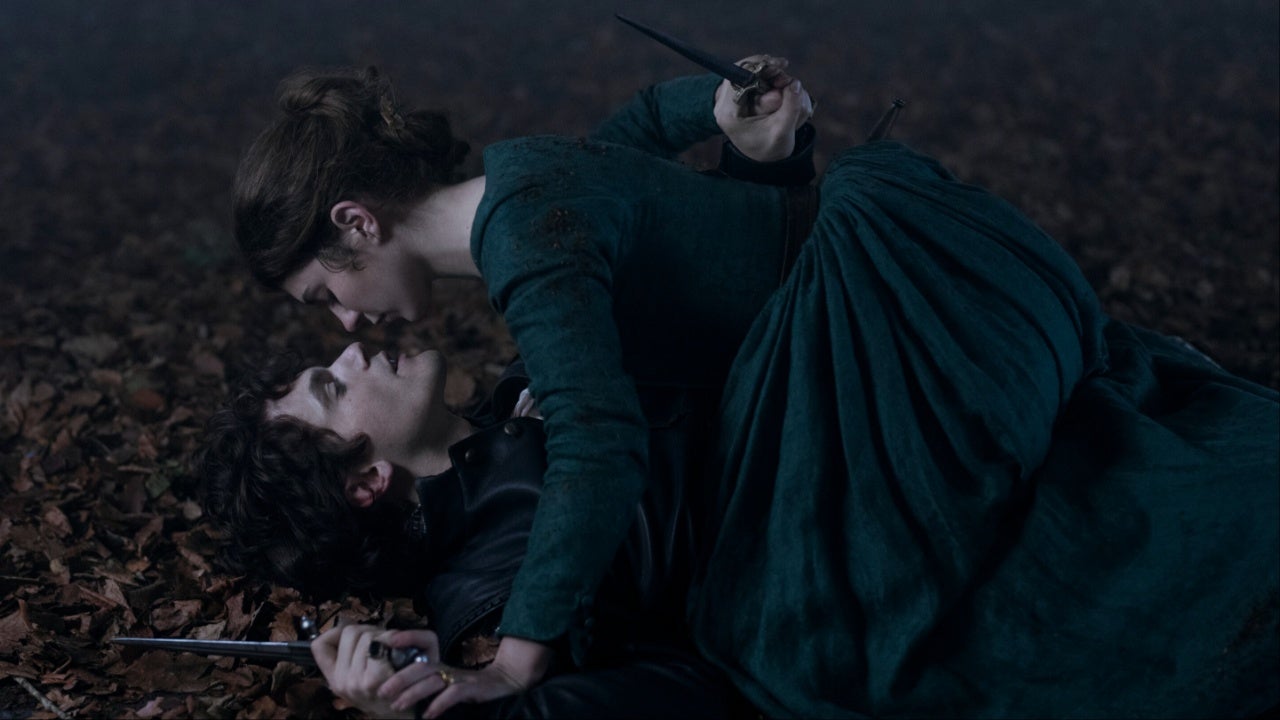My Lady Jane is now streaming on Prime Video.
A lot of British history is deeply depressing. The Black Death, Henry VIII’s many dead wives (by his decree), religious wars, yadda, yadda, yadda. Who hasn’t dozed off trying to muscle through a history textbook chock full of that doom and gloom? All that bleakness inspired authors Cynthia Hand, Brodi Ashton, and Jodi Meadows to take history into their own hands with their revisionist YA novel, My Lady Jane. The 2017 New York Times bestseller reimagines Lady Jane Grey’s tragic, nine day reign as the pawn Queen of England into a fantastical, swoony romance that makes Jane a player in her own story. Under the guidance of writer/showrunner Gemma Burgess (author of the Brooklyn Girls novels), My Lady Jane translates well into an eight episode Prime Video series that confirms, yes, history is a lot more fun and watchable when you take an unrepentantly tongue-in-cheek approach to its telling.
While the series is set in 1553, My Lady Jane takes no time in establishing its anachronistic, irreverent tone and voice through a hand-drawn, animated prologue that immediately earns some big laughs. Through comedically outlandish violence and a deliciously catty commentary from an omniscient narrator (who will continue to show up all season), we’re provided a brief summary of the real history and context for why 17-year-old Lady Jane Grey (Emily Bader) meant anything to the Tudor dynasty. From there, the show is off and running, establishing Grey’s plight as an eldest daughter with no agency in a patriarchal society.
Feeling the financial pinch of widowhood, Lady Frances Grey (Anna Chancellor) has to marry off one of her three daughters so they aren’t left to the mercy of the ancient and lecherous Duke of Leicester (Jim Broadbent). A savvy player of social and political clout, she connects with the equally transactional Lord Dudley, Duke of Northumberland (Rob Brydon), who is looking to marry off his eldest son for political and financial gains (among other hidden agendas that come to light over the course of the series). Neither offspring is interested in the union and Jane, in particular, spends the entire first episode trying to get out of it. Bader quickly establishes herself as a fiery lead who commands her role with genuine empathy, smarts, and quick comedic timing. When Jane comes to accidentally meet her intended, the rakish Lord Guildford Dudley (Edward Bluemel), the pair radiate instant, palpable chemistry, reminiscent of the combustible leads in The Taming of the Shrew.
To the credit of co-showrunners Burgess and Meredith Glynn (The Boys), the smoldering will-they/won’t-they dynamic between Jane and Guildford is not the sole engine of My Lady Jane. There are plentiful layers of political machinations that spiral out from sickly King Edward VI (Jordan Peters) staving off the ambitions of his bitter half-sister Mary Tudor (Kate O’Flynn) and her freak in the sheets Chancellor, Lord Seymour (Dominic Cooper). But the biggest story driver is one of supernatural origin: a conflict between Verities (normal humans) and E∂ians (humans who shapeshift into a specific animal). The monarchy, especially Mary, consider E∂ians abominations so they have a price on their heads that often results in their death. Because of that, E∂ians are hidden in plain sight, living as servants or paupers, and even the occasional highborn too terrified to reveal their true nature… like Jane comes to discover about Guildford.
To add such a high concept twist to a period drama might seem a bridge too far, but it really cements the “outside of history” approach of the series. The Verities/E∂ians division makes the stakes much easier to follow, with the added benefit of surprising character reveals. The device also creates a plausible purpose through which Jane and Guildford can emotionally bond. Initially, they agree she’ll use her education to seek out a cure for his despised “affliction” so they can divorce. But as they come to trust one another, it becomes a reason for them to deepen their connection beyond just attraction. Bader and Bluemel are utterly successful in making us believe in their gradual attraction, whether they’re looking at one another longingly or trading verbal barbs. They’re easy to root, and a strong, beating heart for the show.
Bader and Bluemel are supported by a fantastic cast who, as a company, never miss a beat in finding the right balance between heightened drama and whip-smart comedy. Brydon steals almost every scene he’s in, while the unexpected May-December pairing of Anna Chancellor with Henry Ashton as her besotted lover, Lord Stan Dudley, is a master class in thirst comedy. The show clearly benefits from its primarily female writer’s room, who aren’t shy about embracing a bawdier and more adult presentation of the story. They absolutely capture the book’s blithe approach to history, while adding a bite and intelligence to their dialogue that feels deeply inspired by Rowan Atkinson’s wickedly droll Blackadder, or William Goldman’s The Princess Bride.
History is a lot more fun and watchable when it’s told in this tongue-in-cheek fashion.
There are some pacing problems; My Lady Jane’s eight episodes are overpacked with plot and too many supporting characters. The jauntiness of the performances and the plot swapping gets bogged down by midseason from the burden of servicing too much. For example, King Edward’s story languishes until the final episodes, making it hard to invest in his arc. And there’s not enough cultivation of the wild E∂ians characters, aside from Jane’s friend Susannah (Máiréad Tyers). As a whole, the “pack” of E∂ians rebelling against the crown are treated more like a plot device than well developed characters.
The show’s other weakness is its overreliance on distracting needle drops. A My Lady Jane soundtrack composed entirely of women vocalists is clever on paper, and certainly in keeping with the show’s point of view – but the decision making behind when and where to use the songs is poor. In general, there are too many of them. So much so, that they often pull focus from the real emotions being articulated onscreen. And there’s no cohesion to the selections, a strange mish mash of not-great punky covers with gems like Portishead’s “Glory Box” or Lez Zeppelin’s version of “Kashmir.” It’s so wildly random that the songs often pulled me out of the moment and made me wonder if some songs were chosen for budgetary reasons – and that’s the opposite of what you want your show’s music doing.
My Lady Jane doesn’t bring much that’s new to the increasingly crowded field of cheekily anachronistic period pieces like Bridgerton, Dickinson, and The Great. But it executes on the premise very well. The strong chemistry between Bader and Bluemel means the rom-com elements are firing on all cylinders – and they have a heat worth watching. While the excellent supporting cast brings the spice and humor in spades for a very fun summer watch.












